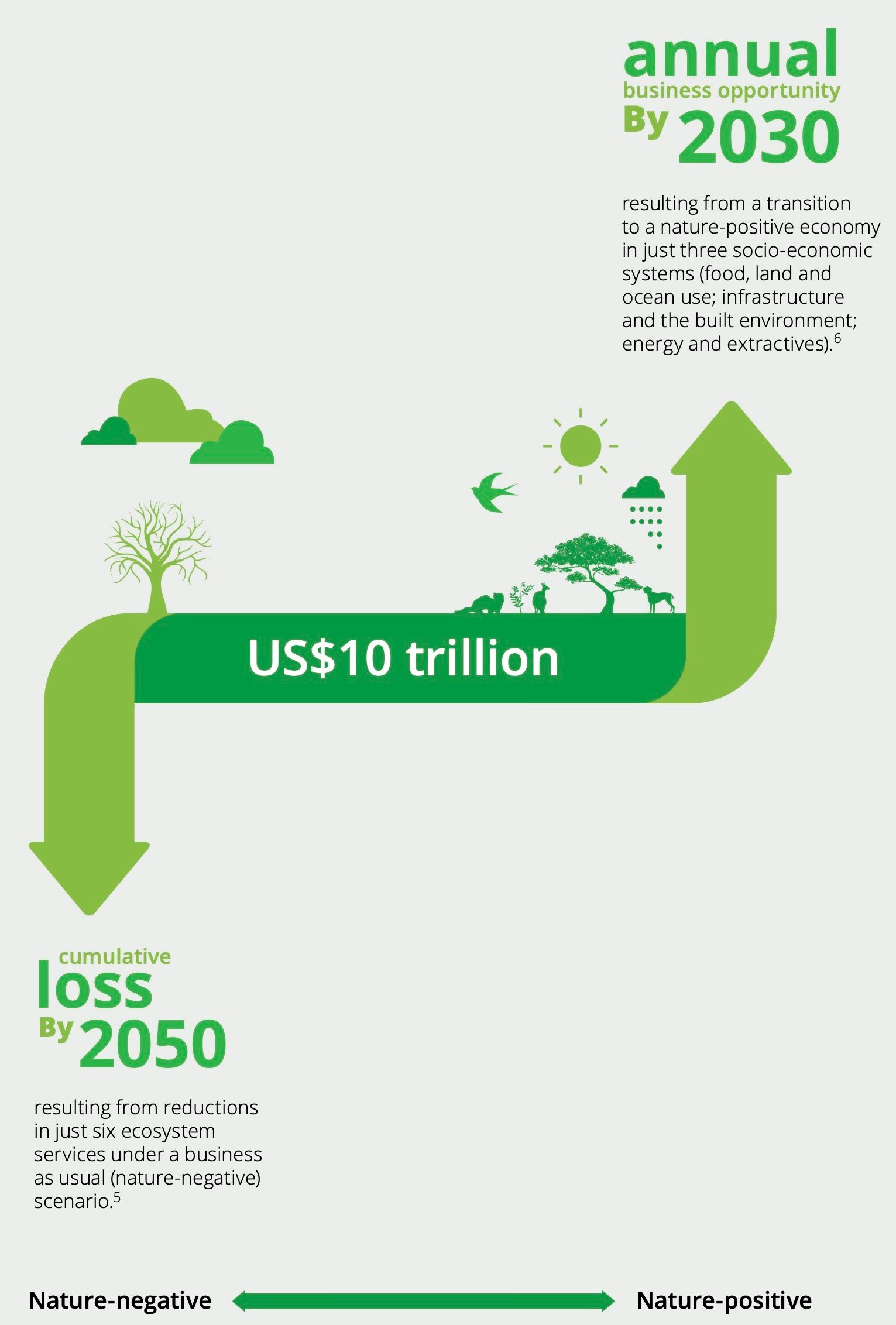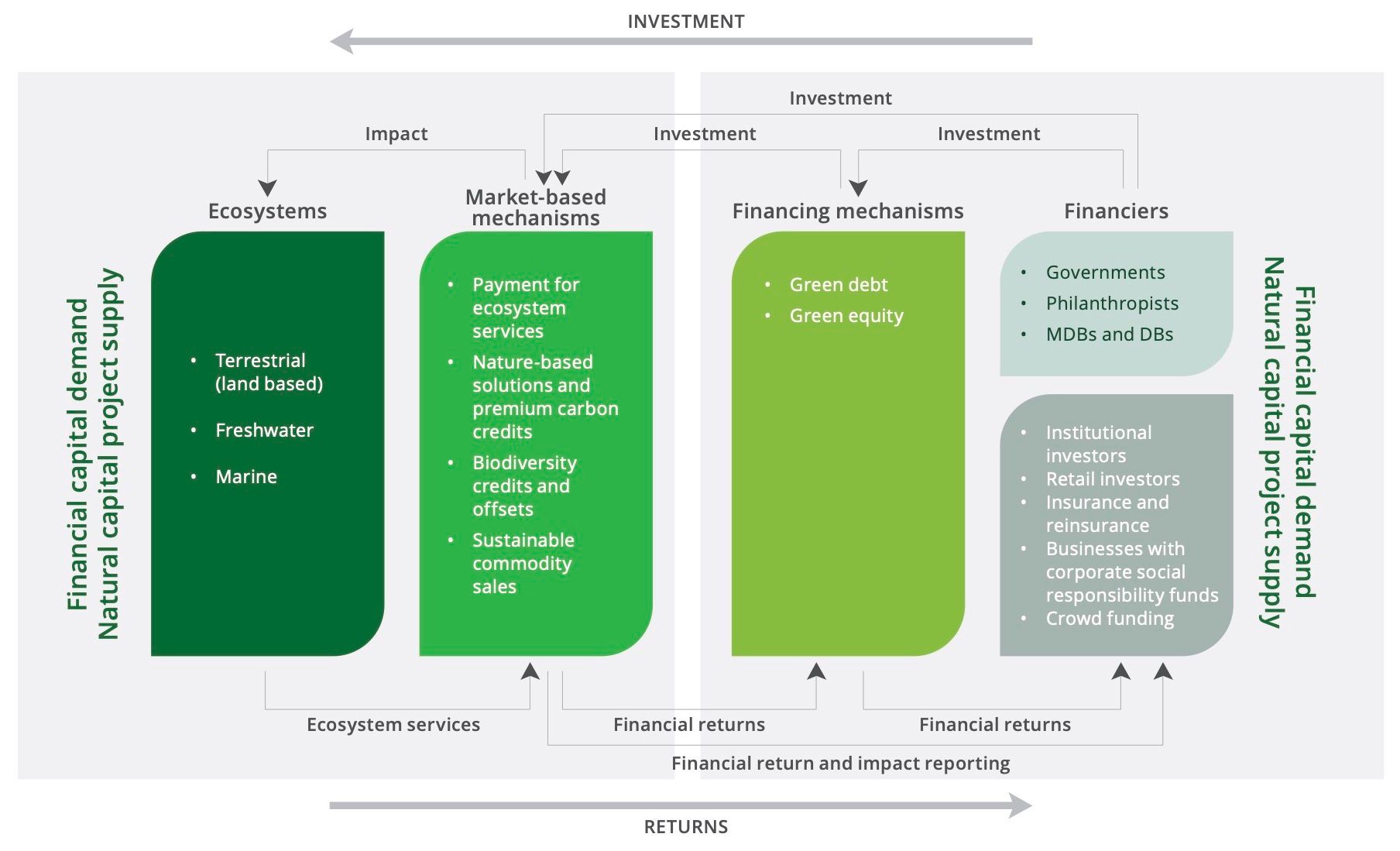Banking on Natural Capital

Unlock the true value of nature
The World Economic Forum (WEF) estimates that more than half of economic output is dependent on nature, and that natural resources are being extracted much faster than they can be restored, all while generating more and more harmful waste products. Yet most of the value derived from nature is an externality (i.e., it has no price and is not priced into decisions) which skews decision making in most business models.
According to estimates by WEF that transitioning to nature-positive practices worldwide presents an annual business opportunity of US$10 trillion by 2030.The financial industry – towards which the report is primarily geared – is well positioned to lead this transition.
The study involved a survey of 20 global organizations in the financial services industry and found that an overwhelming majority was open to making nature-positive commitments and that the financial industry should play a leading role in creating natural capital markets. However there remain many obstacles often requiring decisive government intervention to unluck the potential for the natural capital marketplace.

Demands and drivers for banking on nature
To quantify the economic impact on nature, the concept of ‘ecological footprint’ is used. It takes into account the natural resources used to sustain individuals, a population or an economic activity. Natural-capital supply also represents nature’s ability to replenish its resources and offset the ecological footprint. Data shows that since the 1970s we have accumulated an ecological deficit (see Figure 2). This means ecological resources (forests, biodiversity, etc.) have been used faster than they have been replenished. The goal is to reverse this trend and achieve a nature-positive economy by 2030 with a restored ecological reserve. This is embedded in the UN Convention on Biological Diversity’s 2021 Kunming Declaration signed by over 100 countries, and it is expected that nature-positive commitments, similar to net-zero commitments, become more common among governments and corporations.

There has been a growing shortfall of investment in nature and biodiversity since the 1970s reaching US$598 billion annually, which is poised to increase further to US$722-967 billion annually by 2030. More importantly, about 80% of the (vastly insufficient) funding comes from the public sector, so it is imperative that the private sector step up its investment in nature to help close the gap in replenishment of natural capital.
The most successful example of a marketplace for investment in natural capital is the carbon markets which have sprung up across the globe in the past two decades and aim to help mitigate climate change. Protection and restoration of wetlands, forests and grasslands also have the potential to contribute up to one-third in keeping global warming below 2°C. Protecting ocean resources, one of the largest natural sinks of carbon, has a similar potential climate impact.
To chart a path for promotion of investment in natural capital, the study highlights key factors which act as investment drivers. These include resilience, defense against physical risks, access to ‘green capital’, product differentiation, and anticipation of regulatory compliance. All these can act as value creators for companies with an eye to a more nature-positive business model.
The focus also lies on the actors required to build the marketplaces for transitioning to a nature-positive economy. We distinguish between three core roles: natural-capital supply, enablement of the marketplace (by valuing, tracing, and trading), and natural-capital demand.
Governments and NGOs play a crucial role in enabling natural capital markets and in providing initial natural-capital demand, but financial investors will have to be active in all three roles to scale the market and make it less reliant on public funding. Environmental experts and financial data services firms (such as rating agencies) have the crucial role of creating transparency and traceability through auditing the work of other actors. Corporations, retail investors, and individual land managers/owners act primarily as suppliers and off-takers of natural capital.
Sketching an ecosystem for private investment in natural capital
Unlocking private capital for investment in natural capital requires financing mechanisms for direct capital flows, and for market-based mechanisms that allow the environmental, social, and economic values of natural capital to be monetized.

Monetization allows generation of returns leading to a virtuous cycle of increased investment. The main financing mechanisms are categorized as green debt and green equity, which we estimate to represent a market of US$1.6-3.3 billion and US$2.3-3.0 billion respectively in 2019. Market-based mechanisms such as voluntary and mandatory (mainly carbon) markets for biodiversity and other environmental attributes and certified sustainable commodities (such as forestry, agriculture, fisheries, and palm oil) represented combined markets of US$12.6-18.8 billion in 2019. These market segments are projected to grow substantially in the transition to nature-positive by a factor of five to thirty times by 2030, especially when linked to carbon markets and biodiversity credits.
As to market mechanisms, a clear near-term opportunity is to build on existing carbon markets and include other nature-positive attributes such as biodiversity protection, and soil and water quality in the traded credits, imbuing them with premium value vis a vis ‘conventional’ carbon markets.
Lastly, the study sheds light on the emerging investment ecosystem that enables investment from retail and a broader range of institutional investors in natural-capital investment. To be successful, these vehicles must be connected to real-time evidence of positive impact on natural capital, be liquid and tradable with access to primary and secondary markets, be located on a platform linking the relevant actors, and be verified by third parties that confirm and monitor compliance and disclosure. Multiple examples of existing vehicles and mechanisms are provided in the study for various parts of the emerging investment ecosystem for natural capital.
Making nature-positive a reality
Despite the encouraging developments, several barriers remain to turning a nature-positive economy into reality. Seven key aspects are identified holding back broad investment in natural capital:
Disconnected demand
Not addressing the market failure to internalize natural capital and ecosystem services by quantifying them in economic terms
Shortfall of supply
Lack of cost-effective, high-quality, and market-ready natural capital products
Data and technology
Lack of reliable and harmonized biodiversity and natural-capital data sets prevent efficient monitoring, reporting, and verification
Communicating complexity
Natural capital is intrinsically heterogeneous, complex, and location-dependent, making universally tradable metrics difficult to achieve.
Struggling standards
Absence of a global regulatory or accepted industry standard to define natural capital investments
Capability gaps
Nature-related financial risks are often not well understood and there is a lack of expertise and capabilities to address this shortcoming.
Fairness
Many of the most precious ecosystems are characterized by poverty, inequity, and weak governance. Investment in natural capital must be implemented in an equitable fashion to ensure success.
Governments play a crucial role in addressing these barriers and putting these new markets on solid and transparent footing. There are many examples of governments taking action on individual items, adopting and expanding best practices at a regional and ultimately global scale.
Our proposal is to address environmental disclosure as a high priority by expanding mandatory and voluntary environmental disclosure, which carries little cost for public finances and creates transparency and trust, if done right. The increasing focus on ESG reporting and metrics is an example of how reliable data drives investment decisions.
A second measure to kick-start investment in natural capital is to create tradable property rights or liabilities similar to the right to trade carbon emissions in many parts of the world. And lastly, adjusting fiscal policy (public spending and taxes) to take into consideration the impact on natural capital can help unlock markets for natural capital investment. Pollution tax, investment risk guarantees, and direct public payments for ecosystem services are just a few examples.
Along with the public sector, the financial services industry has a key role to play in adjusting capital allocation with natural-capital preservation in mind. We propose the following steps to transform the industry into an economy which banks on natural capital. This is a ‘Goldilocks’ decade for banking on natural capital.
Commit
Make a time-bound science-based commitment to invest in nature
Channel
Reallocate capital to influence nature-positive activities and behaviors in line with your commitments
Capture
Encourage investees and clients to map their impacts and dependencies on nature
Create
Set up the conditions needed to incentivize investments in nature
Collaborate
Innovate and share access to insightful data
Contact

Bernhard Lorentz
Managing Partner Deloitte Sustainability & Climate GmbH
Global Consulting Sustainability & Climate Strategy Leader